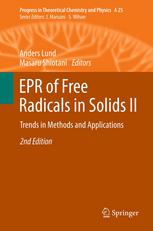

Most ebook files are in PDF format, so you can easily read them using various software such as Foxit Reader or directly on the Google Chrome browser.
Some ebook files are released by publishers in other formats such as .awz, .mobi, .epub, .fb2, etc. You may need to install specific software to read these formats on mobile/PC, such as Calibre.
Please read the tutorial at this link: https://ebookbell.com/faq
We offer FREE conversion to the popular formats you request; however, this may take some time. Therefore, right after payment, please email us, and we will try to provide the service as quickly as possible.
For some exceptional file formats or broken links (if any), please refrain from opening any disputes. Instead, email us first, and we will try to assist within a maximum of 6 hours.
EbookBell Team

4.7
46 reviewsEPR of Free Radicals in Solids: Trends in Methods and Applications, 2nd ed. presents a critical two volume review of the methods and applications of EPR (ESR) for the study of free radical processes in solids. Emphasis is on the progress made in the developments in EPR technology, in the application of sophisticated matrix isolation techniques and in the advancement in quantitative EPR that have occurred since the 1st edition was published. Improvements have been made also at theoretical level, with the development of methods based on first principles and their application to the calculation of magnetic properties as well as in spectral simulations. EPR of Free Radicals in Solids II focuses on the trends in applications of experimental and theoretical methods to extract structural and dynamical properties of radicals and spin probes in solid matrices by continuous wave (CW) and pulsed techniques in nine chapters written by experts in the field. It examines the studies involving radiation- and photo-induced inorganic and organic radicals in inert matrices, the high-spin molecules and metal-based molecular clusters as well as the radical pro-cesses in photosynthesis. Recent advancements in environmental applications in-cluding measurements by myon resonance of radicals on surfaces and by quantitative EPR in dosimetry are outlined and the applications of optical detection in material research with much increased sensitivity reviewed. The potential use of EPR in quantum computing is considered in a newly written chapter. This new edition is aimed to experimentalists and theoreticians in research involving free radicals, as well as for students of advanced courses in physical chemis-try, chemical physics, materials science, biophysics, biochemistry and related fields.